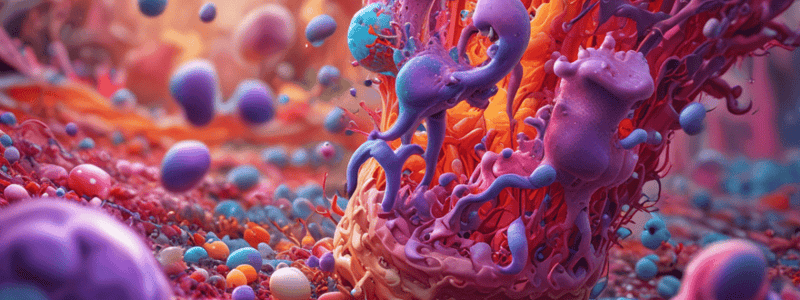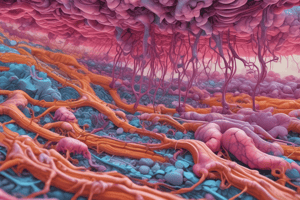Podcast
Questions and Answers
Match the following terms with their definitions:
Match the following terms with their definitions:
Pathology = the study of disease Etiology = the study of the cause of a disease Pathogenesis = the development of disease Infection = invasion or colonization of the body by pathogens
Match the following terms with their descriptions:
Match the following terms with their descriptions:
Symptoms = Changes in body function that are felt by a patient Signs = Changes in a body that can be measured or observed Syndrome = A specific group of signs & symptoms that accompany a disease Disease = an abnormal state in which the body is not performing
Match the following types of infections with their descriptions:
Match the following types of infections with their descriptions:
Local infection = Pathogens are limited to a small area of the body Systemic (generalized) infection = An infection throughout the body Primary infection = Acute infection that causes the initial illness Secondary infection = Caused by opportunistic pathogens after a primary infection
Match the following terms with their explanations:
Match the following terms with their explanations:
Match the following transmission methods with their descriptions:
Match the following transmission methods with their descriptions:
Match the following terms with their definitions:
Match the following terms with their definitions:
Match the following terms with their descriptions:
Match the following terms with their descriptions:
Match the following terms with their functions:
Match the following terms with their functions:
Match the following terms with their roles:
Match the following terms with their roles:
Match the following terms with their descriptions:
Match the following terms with their descriptions:
Match the following terms with their functions:
Match the following terms with their functions:
Match the following terms with their outcomes:
Match the following terms with their outcomes:
Match the following with their functions:
Match the following with their functions:
Match the following terms with their meanings:
Match the following terms with their meanings:
Match the following T cell types with their functions:
Match the following T cell types with their functions:
Match the following terms with their descriptions:
Match the following terms with their descriptions:
Pathology is the study of ______.
Pathology is the study of ______.
______ is the study of the cause of a disease.
______ is the study of the cause of a disease.
Pathogenesis is the ______ of disease.
Pathogenesis is the ______ of disease.
Infection is the ______ or colonization of the body by pathogens.
Infection is the ______ or colonization of the body by pathogens.
Disease is an ______ state in which the body is not performing.
Disease is an ______ state in which the body is not performing.
Symptoms are ______ in body function that are felt by a patient.
Symptoms are ______ in body function that are felt by a patient.
Signs are ______ in a body that can be measured or observed.
Signs are ______ in a body that can be measured or observed.
A ______ is a specific group of signs and symptoms that accompany a disease.
A ______ is a specific group of signs and symptoms that accompany a disease.
A ______ disease is not spread from one host to another.
A ______ disease is not spread from one host to another.
Host defenses provide the ability of the host to remove ______ in order to prevent disease.
Host defenses provide the ability of the host to remove ______ in order to prevent disease.
______ microbes are one organism that benefits while the other organism (host) is unaffected.
______ microbes are one organism that benefits while the other organism (host) is unaffected.
______ microbes provide something to the host.
______ microbes provide something to the host.
______ microbes act as pathogens under certain circumstances.
______ microbes act as pathogens under certain circumstances.
Normal microbiota ______ with pathogens (invading microbes), leading to decreased populations of pathogenic bacteria.
Normal microbiota ______ with pathogens (invading microbes), leading to decreased populations of pathogenic bacteria.
______ are leukocytes with granules in their cytoplasm that are visible with a light microscope.
______ are leukocytes with granules in their cytoplasm that are visible with a light microscope.
______ release histamine and are involved in allergic responses.
______ release histamine and are involved in allergic responses.
______ are toxic against parasites and worms.
______ are toxic against parasites and worms.
______ are phagocytic, work in the early stages of infection, and are the first responders.
______ are phagocytic, work in the early stages of infection, and are the first responders.
The ______ helps form blood clots, stopping blood flow so host defenses cannot reach the bacterium.
The ______ helps form blood clots, stopping blood flow so host defenses cannot reach the bacterium.
______ is the ability of a pathogen to produce a toxin.
______ is the ability of a pathogen to produce a toxin.
A ______ is a chemically modified toxin which is no longer toxic.
A ______ is a chemically modified toxin which is no longer toxic.
An ______ is an antibody against a toxin.
An ______ is an antibody against a toxin.
______ is the ability of pathogens to attach to host tissues or cells.
______ is the ability of pathogens to attach to host tissues or cells.
______ breaks down hyaluronic acid in connective tissue.
______ breaks down hyaluronic acid in connective tissue.
______ breaks down collagen in connective tissue.
______ breaks down collagen in connective tissue.
An ______ is something that acts as an antigen.
An ______ is something that acts as an antigen.
The ______ protects the human host.
The ______ protects the human host.
Complement proteins coat the surface of a ______ to promote attraction and attachment of phagocytes.
Complement proteins coat the surface of a ______ to promote attraction and attachment of phagocytes.
Complement proteins bind ______ cells, which release histamine to increase blood vessel permeability and attract phagocytes.
Complement proteins bind ______ cells, which release histamine to increase blood vessel permeability and attract phagocytes.
Complement proteins can create a ______ that forms a hole in the pathogen's cell wall or membrane.
Complement proteins can create a ______ that forms a hole in the pathogen's cell wall or membrane.
Immunology is the study of host defenses against ______ substances.
Immunology is the study of host defenses against ______ substances.
______ immunity fights invaders and threats outside of the cell.
______ immunity fights invaders and threats outside of the cell.
______ T cells activate TC cells involved in cell-mediated immunity and certain B cells to produce antibodies.
______ T cells activate TC cells involved in cell-mediated immunity and certain B cells to produce antibodies.
______ T cells destroy target cells on contact.
______ T cells destroy target cells on contact.
______ T cells suppress or turn off the immune response when it is not needed.
______ T cells suppress or turn off the immune response when it is not needed.
______ T cells produce a delayed and exaggerated immune response.
______ T cells produce a delayed and exaggerated immune response.
______ T cells promote a relatively rapid immune response upon subsequent exposure to the same antigen.
______ T cells promote a relatively rapid immune response upon subsequent exposure to the same antigen.




